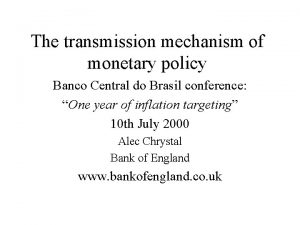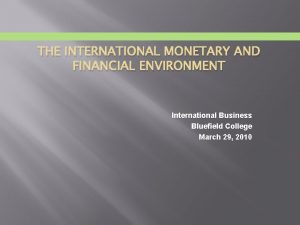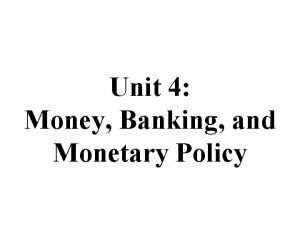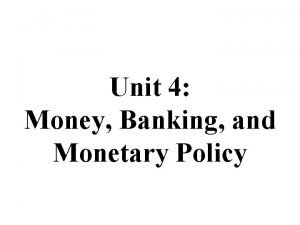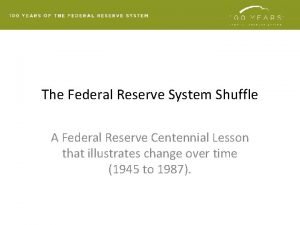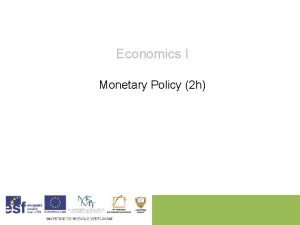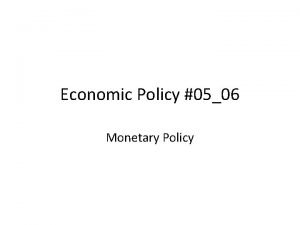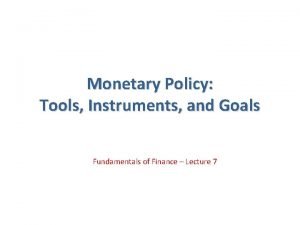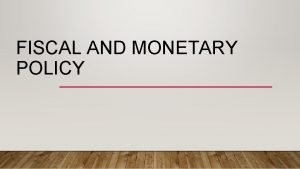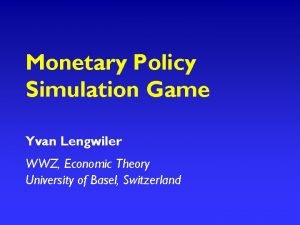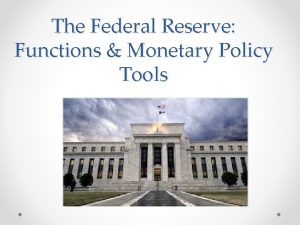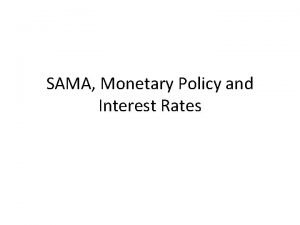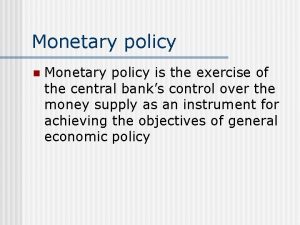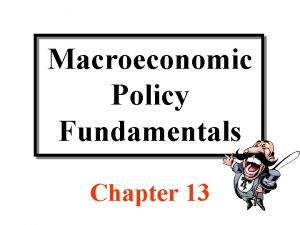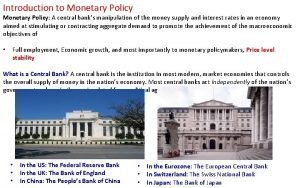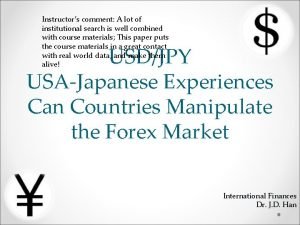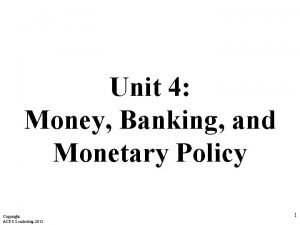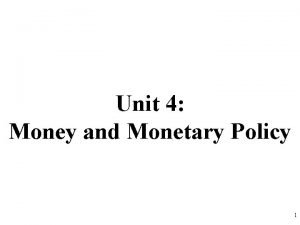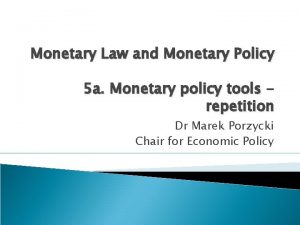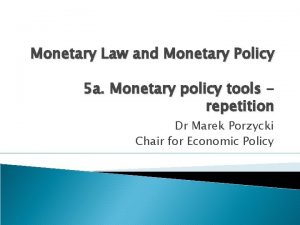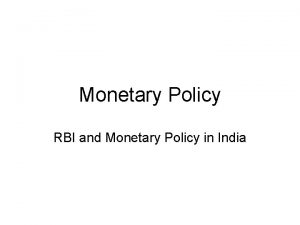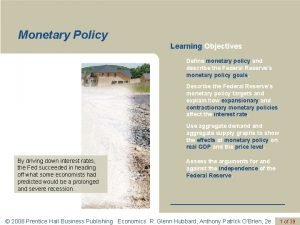The international transmission of monetary policy through financial































- Slides: 31

The international transmission of monetary policy through financial centres: evidence from the United Kingdom and Hong Kong Robert Hills, Kelvin Ho, Dennis Reinhardt, Rhiannon Sowerbutts, Eric Wong, and Gabriel Wu 30 June 2017 Global Financial Linkages and Monetary Policy Transmission JIMF-IBRN-Bu. Ba-Bd. F-PSE Conference Any views expressed are solely those of the authors and so should not be taken to represent those of the Bank of England or the Hong Kong Monetary Authority.

Main Questions How does monetary policy in systemic countries (US, EA, Japan) affect bank lending in the UK and HK? 1. Does the transmission depend on financial linkages or balance sheet structure of banks? 2. Does it matter which currency the lending is denominated in? Policy relevance: Aggregate data used in previous studies may mask offsetting individual bank effects Host-country supervisors may need to take into account heterogeneities in banks’ financial linkages and balance sheet structures

Transmission channels A tightening of monetary policy abroad can, in principle, impact on lending to real or financial sectors in both the UK and HK, positively or negatively, depending on the relative strength of: • Bank funding channel (Bernanke and Blinder, 1992, Disyatat, 2010) – Banks face more constraints in funding after a tightening in MP reduce real and financial sector lending at home and abroad • Portfolio channel (Bernanke and Gertler, 1995) – When MP tightens, borrowers at home become less creditworthy and ( ) banks increase real sector lending to other countries to keep their overall portfolio of risk unchanged.

Why a joint HK/UK paper? Focus on financial centres • Both HK and UK are important financial centres: – – Global funding/lending hubs with diverse financial linkages Wide variety of foreign banks, different organisational forms FX-denominated lending (variety of currencies) High importance of both real and financial sector lending • Differences between HK and UK banking systems in how strongly different bank types (domestic-owned, foreign subs or branches) are financially linked influences our priors and focus of analysis – UK: focus on all banks – HK: focus on foreign branches

Characteristics of the UK and HK banking sectors • As international financial centres, large presence of foreign banks (they account for nearly half of total banking system assets in both the UK and HK) • The UK banking sector has a more even mix of foreign bank branches and subsidiaries • While, HK banking sector is more dominated by foreign bank branches

Characteristics of the UK banking sector • In terms of financial linkages, all UK banks (domestic-owned banks, foreign subsidiaries and branches) have sizable lending/funding with rest of world, especially with systemic countries • Almost 25% of banks’ assets are in the euro area, with Japan and the USA accounting together for another 10%. • Net funding linkages vary strongly depending on the bank. On average, UK banks are net dependent on financing from abroad

Characteristics of the HK banking sector • While in HK, foreign bank branches are highly integrated with their parent banks. Other types of banks are less integrated with foreign countries in terms of funding Notes: 1. Position as of end-2015 2. Systemic countries refer to the US, Euro Area, Japan and the UK Source: HKMA

Banking system characteristics and implications for empirical analysis • The structural differences between the two banking sectors allows us to explore two different forms of transmission channels: Ø For the UK, given all types of UK banks have sizeable financial linkages with systemic countries, we focus on all bank types to: Ø Directly estimate the relevance of financial linkages for the transmission of MP from systemic countries to UK bank lending Ø For HK, given the dominance of foreign branches (FBHKs) and differences in the liability structure between them and other types of banks, we focus on branches from systemic countries to: Ø Estimate how changes in MP in system foreign branches’ home countries impacts bank lending in Hong Kong… Ø …. while going a step further and explore how the balance sheet characteristics of parent banks influence the transmission of MP from home countries to their branches in Hong Kong

Changes in monetary policy for global banks’ home country Foreign economy Changes in monetary policy in respective economy Japan economy Euro Area economy US economy Japan Euro Area US UK Global banks Cross border liabilities Domestic economy Cross border claims Global bank’s business model and funding to its foreign branches Banks in UK (domestic-owned, foreign bank subsidiaries and branches) Lending UK economy UK: Inward transmission through UK banks’ financial linkage with systemic countries Domestic branches of foreign global banks Lending HK economy HK: Inward transmission through domestic branches of foreign global banks

Results preview: ‘funding’ and ‘portfolio’ channels For ‘bank funding’ channel Ø UK banks which are more dependent on Japan for net funding show a more negative change in their financial lending following a tightening of MP in Japan Ø But stronger evidence for FX bank funding channel: Japanese MP transmits via USD and Euro lending in UK. And US MP via USD lending in UK. Ø Foreign branches in HK whose parent is less reliant on wholesale funding have higher loan growth to the real sector when MP is tightened in the parent country Ø HK: No significant difference in the transmission of MP via HKD or USD lending, perhaps reflecting the stable linked exchange rate system

Results preview: ‘funding’ and ‘portfolio’ channels For ‘portfolio’ channel Ø UK banks with a higher share of their claims on the EA or US experience a more positive change in their bank lending growth to UK real sectors when MP is tightened in EA or US Ø Results driven by sterling-denominated lending Ø FBHKs whose parent bank has more lending business increase their lending in HK by more when MP is tightened in the parent country Ø HK: No significant difference in the transmission of MP via HKD or USD lending

Data • Bank level data and balance sheet characteristics Ø Quarterly data spanning from 2000 Q 1 to 2015 Q 4 Ø UK: Bank balance sheet using raw data from the Bank of England’s regulatory reporting forms Ø HK: Branch-level variable for FBHKs using regulatory data from the HKMA, while parent-level variables are constructed using consolidated data of the ultimate parent from SNL and S&P Capital IQ • Monetary policy measures Ø QE data and short-term policy rates are from national sources Ø Two-factor shadow policy rate as described in Krippner (2015) - Estimated level of the shadow rate is sensitive to the assumption underlying the specification, but changes in shadow rates more consistent across specifications

Appropriate financial linkages to test bank funding and portfolio channels – HK and UK • For bank funding channel: The extent of transmission tends to be higher if the bank has a higher reliance on wholesale funding from the country tightening monetary policy – For UK, we use the respective banks’ net funding from the country which tightens MP (% of total liabilities) – For HK, we use the parent bank’s core deposit ratio (Other measures include parent bank’s liquid asset ratio, and FBHKs’ Net due to (overseas offices). • For portfolio channel: The transmission is stronger the more lending the bank does to/in the country tightening monetary policy – For UK we use gross lending to ctry’s non-bank sector (% of total assets). – For HK we use the parent bank’s loan-to-asset ratio (Other measures include parent bank’s share of securities to assets, tier-1 ratio and impaired loan ratio)

Empirical Specification: UK • •

Empirical Specification: HK • •

Main Questions How does monetary policy in systemic countries (US, EA, Japan) affect bank lending in the UK and HK? 1. Does the transmission depend on financial linkages or balance sheet structure of banks? 2. Does it matter which currency the lending is denominated in?

The bank funding channel: UK

The bank funding channel: UK • • Banks more dependent on net interbank funding from Japan show a more negative change in their interbank lending in the UK than other banks, once Japan increases its short rates Why stronger evidence than for US/EA? Banks exposed to Japan are often Japanese affiliates with strong funding linkages to their home country: lost funding harder to substitute + need to take into account currency denomination.

The bank funding channel: UK • Net funding linkages do not appear to change the transmission of changes in QE – i. e. limited bank funding channel as hypothesised for UMPs.

Bank funding channel on real sector lending: HK • Evidence of bank funding channel for lending to the real economy: FBHKs whose parent relies less on wholesale funding tends to attain higher loan growth than other banks after MP tightening at home • … for changes in both conventional (short rates) and unconventional monetary policy (QE)

Bank funding channel on interbank lending: HK • In contrast to the UK results, no strong evidence of conventional monetary policy spillovers via FBHKs’ interbank lending • However, there is tentative evidence to suggest that the bank funding channel may be at work during periods of unconventional monetary policy: – when the home country expands QE, for a more liquidity-constrained parent bank (i. e. lower liquid asset ratios), its FBHK tends tend to increase interbank lending by a greater extent relative to its counterparts

The portfolio channel: UK

The portfolio channel: UK • Focusing first on CMPs: – Banks with a higher share of their claims in the US/EA experience a more positive change in their bank lending growth to UK real sectors following a tightening in short rates. – Lack of significance for Japan likely due to small exposures of UK banks to Japanese non-banks and a lack of variation in Japanese CMPs

The portfolio channel: UK • Mixed results for UMPs: – Evidence for changes in shadow rates give evidence consistent with the PF channel – QE has negative coefficients (i. e. banks more exposed show a more positive change for tightening) for US, EA and Japan but only significant for the latter.

Portfolio channel on real sector lending: HK • The FBHK of a parent bank with a higher loan-to-asset ratio displays higher loan growth to the real sector in HK when the home country tightens MP(consistent with PF channel) • Although no strong evidence for QE, the above results remain consistent when changes in shadow rate are used • Similar effect is also found on parent banks with a larger holding of securities

Main Questions How does monetary policy in systemic countries (US, EA, Japan) affect bank lending in the UK and HK? 1. Does the transmission depend on financial linkages or balance sheet structure of banks? 2. Does it matter which currency the lending is denominated in?

Currency denomination of lending: funding channel • Results for the bank funding channel are driven by foreigncurrency denominated lending: a tightening in US monetary policy leads to a larger negative change in $-denominated financial lending by banks dependent on the US for net funding. • Lack of significance for EA MP and € lending could be explained by the currency denomination of financial linkages: while, on average, most funding from the US is in $, only around half of funding from the EA is denominated in €.

Currency denomination of lending: PF channel • Results for the portfolio channel are driven by sterling-denominated lending (consistent with Brauning and Ivashina, 2017)

Currency dimension for bank funding channel: HK • Similar to UK, we find evidence of bank funding channel on FBHKs’ USD lending to real sector when their home-country monetary policy tightens • But we also find significant spillover effect on FBHKs’ HKD real sector lending through this channel

Currency dimension for portfolio channel: HK • Evidence of portfolio channel in both USD and HKD real sector lending of FBHKs No significant difference in the transmission of MP via HKD or USD lending for both bank funding and portfolio channels. May reflect the longstanding stable linked exchange rate system

Conclusion • Evidence of both ‘bank funding’ and ‘portfolio’ channels in both UK and HK banking sectors • The currency denomination of lending plays an important role in the UK, while it is less important for HK, possibly due to the stable linked exchange rate system • Overall impact of international monetary policy spillover on banks’ lending is heterogeneous, determined by – financial linkages with systemic countries (UK banks) – or balance sheet characteristics of their parent banks (FBHKs) • Host country’ policy makers should take into account such heterogeneities when assessing the international spillover of monetary policy
 Transmission mechanism
Transmission mechanism International monetary and financial environment
International monetary and financial environment International financial environment
International financial environment Open market operations
Open market operations Unit 4 money banking and monetary policy
Unit 4 money banking and monetary policy Unit 4 money banking and monetary policy
Unit 4 money banking and monetary policy Lesson quiz 16-1 monetary policy
Lesson quiz 16-1 monetary policy Objectives of monetary policy
Objectives of monetary policy Meaning of monetary
Meaning of monetary Types of monetary policy
Types of monetary policy Unit 5 lesson 2 fiscal and monetary policy
Unit 5 lesson 2 fiscal and monetary policy What are the objectives of monetary policy
What are the objectives of monetary policy What are the objectives of monetary policy
What are the objectives of monetary policy Contractory monetary policy
Contractory monetary policy Three tools of monetary policy
Three tools of monetary policy Monetary policy summary
Monetary policy summary Fiscal vs monetary policy
Fiscal vs monetary policy Monetary policy simulation game
Monetary policy simulation game Types of monetary policy
Types of monetary policy Instruments of monetary policy
Instruments of monetary policy Conclusion of monetary policy
Conclusion of monetary policy Moral suasion examples
Moral suasion examples Monetary policy
Monetary policy Tools of monetary policy ppt
Tools of monetary policy ppt Instruments of monetary policy
Instruments of monetary policy Expansionary monetary policy flow chart
Expansionary monetary policy flow chart Monetary policy
Monetary policy Expansionary money policy
Expansionary money policy Contractionary policy
Contractionary policy Features of fiscal policy ppt
Features of fiscal policy ppt Unit 4 money and monetary policy
Unit 4 money and monetary policy Unit 4 money and monetary policy
Unit 4 money and monetary policy
